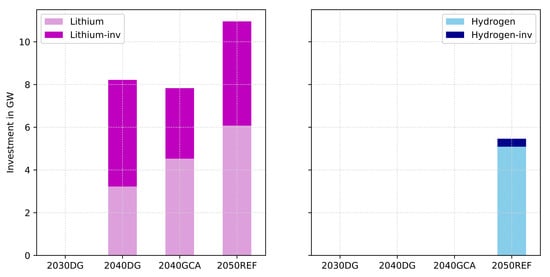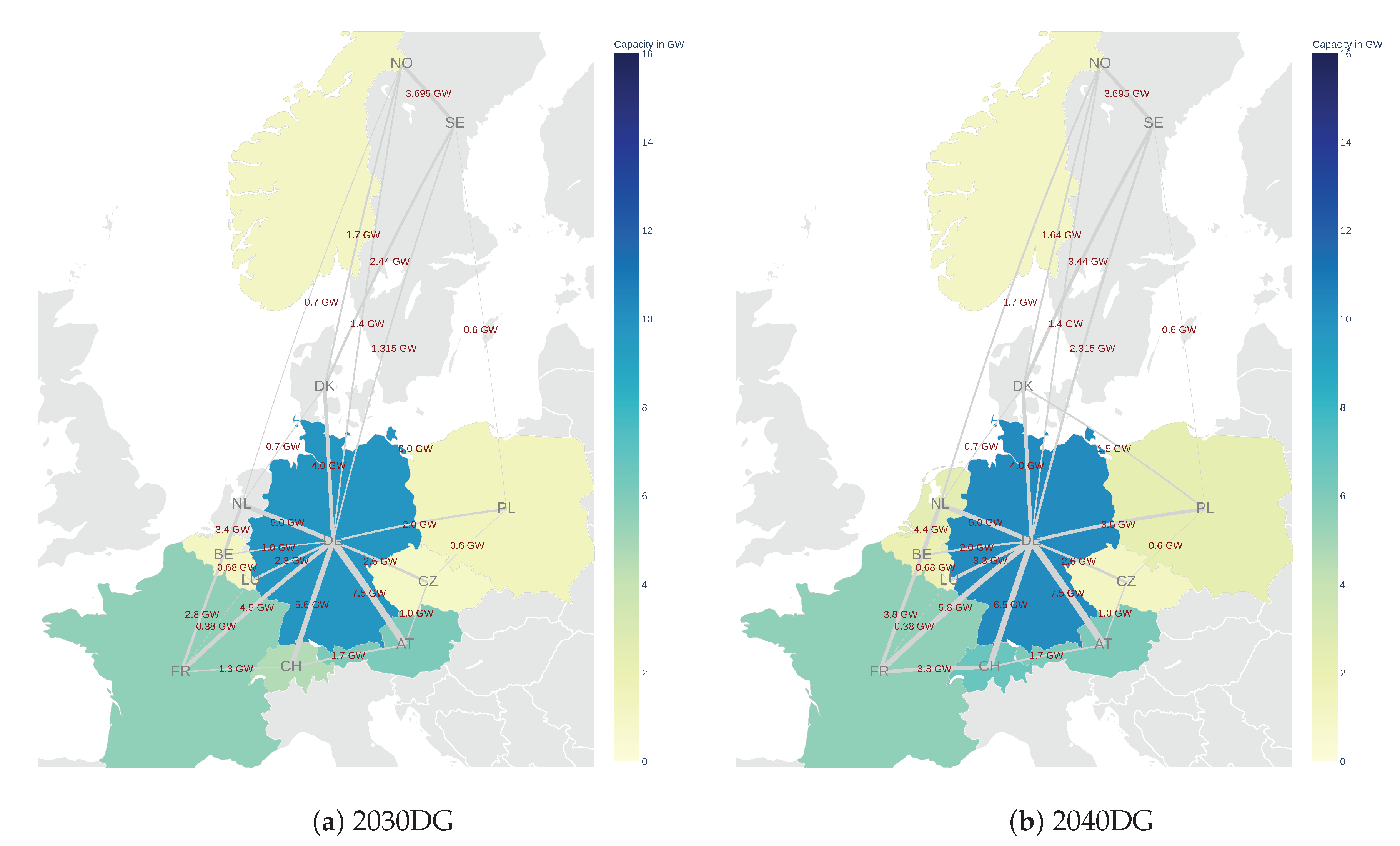Effects of Decentral Heat Pump Operation on Electricity Storage Requirements in Germany
Abstract
1. Introduction
2. State of Art and Research Question
3. Method
Mathematical Description
4. Scenarios
4.1. Installed Capacities
4.2. Demand
4.3. Investment Data
4.4. Renewable Generation
5. Results
5.1. Heating System Investment
5.2. Electricity Storage Investment
5.3. System Costs
5.4. Storage Dynamics
5.5. Sensitivities
6. Discussion
7. Conclusions
Funding
Conflicts of Interest
Abbreviations
| COP | Coefficient of Performance |
| FOM | Fixed Operation and Maintenance |
| HP | Heat Pump |
| IPCC | Intergovermental Panel on Climate Change |
| LP | Linear Programming |
| PHS | Pumped Hydro Storage |
| PV | Photovoltaic |
| RE | Renewable Energy |
| RoR | Run of River |
| TES | Thermal energy storage |
| TYNDP | Ten Year Network Development Plan |
| WACC | Weighted Average Cost of Capital |
Appendix A. Model Symbols
| Symbol | Description |
|---|---|
| C | Set of all conversion processes |
| D | Set of all dispatchable generators |
| H | Set of all heat pumps |
| K | Set of all commodities |
| L | Set of all loads |
| N | Set of all transmission lines |
| R | Set of all reservoir units |
| S | Set of all storage units |
| T | Set of all timesteps |
| V | Set of all volatile generators |
| Symbol | Description |
|---|---|
| Energy flow at timestep t | |
| Heat flow to heat bus from heat pump h timestep t | |
| Storage (energy) level of storage s at timestep t | |
| Thermal capacity of heat pump h | |
| Capacity (power) of storage s | |
| Storage capacity (energy) of storage s |
| Symbol | Description |
|---|---|
| Marginal cost of generator g | |
| Commodity cost of generator g | |
| Variable operational and maintenance cost of generator g | |
| Absolute amount of commodity k | |
| Loss of storage energy per timestep t | |
| Profile of generator, reservoir or load timestep t | |
| Capacity of dispatchable or volatile generator d / v | |
| Loss on transmission line n | |
| Emission factor of carrier e | |
| Efficiency of conversion process c at timestep t | |
| Charge efficiency of storage s | |
| Dis-charge efficiency of storage s |
Appendix B. Scenario Assumptions
Appendix B.1. Residual Load
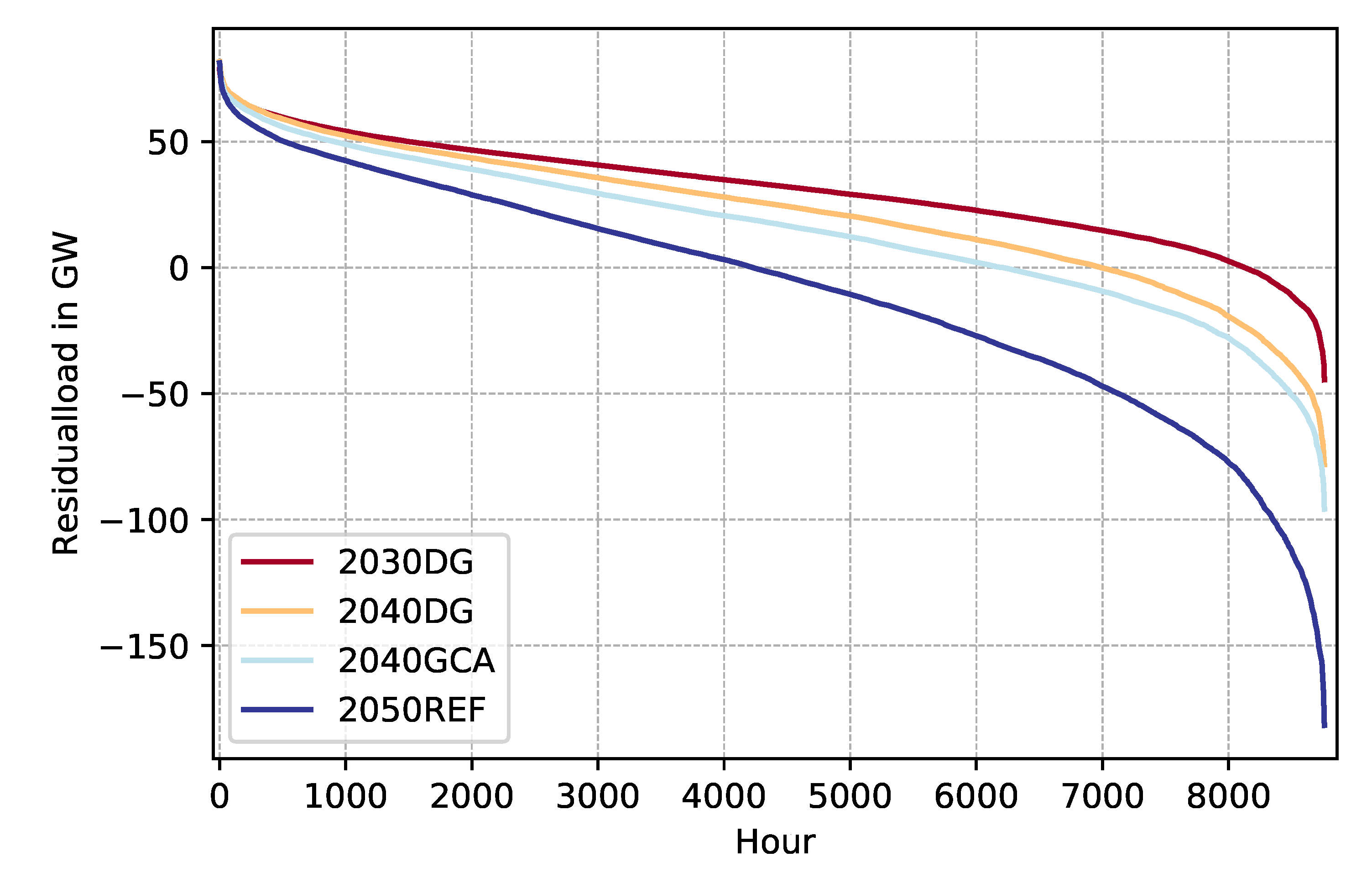
Appendix B.2. Renewable Energy and Biomass Potentials
| Offshore | Onshore | PV | RoR | |
|---|---|---|---|---|
| Country | ||||
| AT | - | 1507 | 1291 | 3058 |
| BE | 3939 | 2406 | 1135 | 1335 |
| CH | - | 1354 | 1416 | 3832 |
| CZ | - | 1875 | 1226 | 1974 |
| DE | 3976 | 1951 | 1151 | 4043 |
| DK | 4224 | 2670 | 977 | - |
| FR | 3295 | 2040 | 1265 | 2722 |
| LU | - | 2917 | 1192 | 2644 |
| NL | 4025 | 1921 | 1095 | 1518 |
| NO | 4341 | 3562 | 811 | 2028 |
| PL | 3964 | 1834 | 1113 | 1493 |
| SE | 3792 | 2654 | 862 | 2161 |
| AT | BE | CH | CZ | DE | DK | FR | LU | NL | NO | PL | SE | |
|---|---|---|---|---|---|---|---|---|---|---|---|---|
| Amount in TWh | 23.61 | 8.08 | 0.0 | 32.78 | 45.05 | 13.56 | 149.56 | 0.61 | 2.81 | 0.0 | 71.36 | 86.75 |
Appendix B.3. Grid Capacities
References
- United Nations. Paris Agreement. 2015. Available online: http://unfccc.int/files/essential_background/convention/application/pdf/english_paris_agreement.pdf (accessed on 15 April 2020).
- IPCC. Global Warming of 1.5 °C—Special Report 15. Technical Report. 2018. Available online: https://www.ipcc.ch/sr15/ (accessed on 15 April 2020).
- Hansen, K.; Vad Mathiesen, B. Comprehensive assessment of the role and potential for solar thermal in future energy systems. Sol. Energy 2018, 169, 144–152. [Google Scholar] [CrossRef]
- Millstein, D.; Wiser, R.; Bolinger, M.; Barbose, G. The climate and air-quality benefits of wind and solar power in the United States. Nat. Energy 2017, 2, 17134. [Google Scholar] [CrossRef]
- Haberl, H.; Erb, K.H.; Krausmann, F.; Running, S.; Searchinger, T.D.; Smith, W.K. Bioenergy: How much can we expect for 2050? Environ. Res. Lett. 2013, 8, 031004. [Google Scholar] [CrossRef]
- Creutzig, F.; Ravindranath, N.H.; Berndes, G.; Bolwig, S.; Bright, R.; Cherubini, F.; Chum, H.; Corbera, E.; Delucchi, M.; Faaij, A.; et al. Bioenergy and climate change mitigation: An assessment. GCB Bioenergy 2015, 7, 916–944. [Google Scholar] [CrossRef]
- Brown, T.; Bischof-Niemz, T.; Blok, K.; Breyer, C.; Lund, H.; Mathiesen, B. Response to ‘Burden of proof: A comprehensive review of the feasibility of 100% renewable-electricity systems’. Renew. Sustain. Energy Rev. 2018, 92, 834–847. [Google Scholar] [CrossRef]
- Sterchele, P.; Palzer, A.; Henning, H.M. The role of heat pumps in the transformation of national energy systems-Example Germany. In Proceedings of the 12th IEA Heat Pump Conference, Rotterdam, The Netherlands, 15–18 May 2017. [Google Scholar]
- Blum, P.; Campillo, G.; Münch, W.; Kölbel, T. CO2 savings of ground source heat pump systems—A regional analysis. Renew. Energy 2010, 35, 122–127. [Google Scholar] [CrossRef]
- Connolly, D.; Lund, H.; Mathiesen, B.V. Smart Energy Europe: The technical and economic impact of one potential 100% renewable energy scenario for the European Union. Renew. Sustain. Energy Rev. 2016, 60, 1634–1653. [Google Scholar] [CrossRef]
- Brown, T.; Schlachtberger, D.; Kies, A.; Schramm, S.; Greiner, M. Synergies of sector coupling and transmission reinforcement in a cost-optimised, highly renewable European energy system. Energy 2018, 160, 720–739. [Google Scholar] [CrossRef]
- Palzer, A.; Henning, H.M. A comprehensive model for the German electricity and heat sector in a future energy system with a dominant contribution from renewable energy technologies—Part II: Results. Renew. Sustain. Energy Rev. 2014, 30, 1019–1034. [Google Scholar] [CrossRef]
- Merkel, E.; McKenna, R.; Fehrenbach, D.; Fichtner, W. A model-based assessment of climate and energy targets for the German residential heat system. J. Clean. Prod. 2017, 142, 3151–3173. [Google Scholar] [CrossRef]
- Katja Purr, E.; Günther, J.; Lehmann, H.; Nuss, P. Wege in Eine Ressourcenschonende Treibhausgasneutralität—RESCUE: Langfassung; Umweltbundesamt. 2019. Available online: https://www.umweltbundesamt.de/en/rescue (accessed on 22 January 2020).
- Paardekooper, S.; Lund, R.S.; Mathiesen, B.V.; Chang, M.; Petersen, U.R.; Grundahl, L.; David, A.; Dahlbæk, J.; Kapetanakis, I.A.; Lund, H.; et al. Heat Roadmap Germany: Quantifying the Impact of Low-Carbon Heating and Cooling Roadmaps. 2018. Available online: https://vbn.aau.dk/ws/portalfiles/portal/287930627/Country_Roadmap_Germany_20181005.pdf (accessed on 3 June 2020).
- Bloess, A.; Schill, W.P.; Zerrahn, A. Power-to-heat for renewable energy integration: A review of technologies, modeling approaches, and flexibility potentials. Appl. Energy 2018, 212, 1611–1626. [Google Scholar] [CrossRef]
- Hedegaard, K.; Münster, M. Influence of individual heat pumps on wind power integration—Energy system investments and operation. Energy Convers. Manag. 2013, 75, 673–684. [Google Scholar] [CrossRef]
- Bernath, C.; Deac, G.; Sensfuß, F. Influence of heat pumps on renewable electricity integration: Germany in a European context. Energy Strategy Rev. 2019, 26, 100389. [Google Scholar] [CrossRef]
- Ruhnau, O.; Hirth, L.; Praktiknjo, A. Heating with Wind: Economics of Heat Pumps and Variable Renewables; Technical Report; ZBW—Leibniz Information Centre for Economics: Kiel/Hamburg, Germany, 2019. [Google Scholar]
- Fehrenbach, D.; Merkel, E.; McKenna, R.; Karl, U.; Fichtner, W. On the economic potential for electric load management in the German residential heating sector—An optimising energy system model approach. Energy 2014, 71, 263–276. [Google Scholar] [CrossRef]
- Bloess, A. Impacts of heat sector transformation on Germany’s power system through increased use of power-to-heat. Appl. Energy 2019, 239, 560–580. [Google Scholar] [CrossRef]
- Cebulla, F.; Haas, J.; Eichman, J.; Nowak, W.; Mancarella, P. How much electrical energy storage do we need? A synthesis for the U.S., Europe, and Germany. J. Clean. Prod. 2018, 181, 449–459. [Google Scholar] [CrossRef]
- Schill, W.P.; Zerrahn, A. Long-run power storage requirements for high shares of renewables: Results and sensitivities. Renew. Sustain. Energy Rev. 2018, 83, 156–171. [Google Scholar] [CrossRef]
- Maximilian, R. Kühne. Drivers of Energy Storage Demand in the German Power System: An Analysis of the Influence of Methodology and Parameters on Modelling Results. Ph.D. Thesis, Technical University Munich, Munich, Germany, 2016. Available online: https://mediatum.ub.tum.de/doc/1280982/1280982.pdf (accessed on 15 April 2020).
- Pape, C.; Gerhardt, N.; Härtel, P.; Scholz, A.; Schwinn, R.; Drees, T.; Maaz, A.; Sprey, J.; Breuer, C.; Moser, A.; et al. Roadmap Speicher-Speicherbedarf für Erneuerbare Energien-Speicheralternative-Speicheranreiz-Überwindung Rechtlicher Hemmnisse; Endbericht: Würzburg, Germany, 2014; Available online: https://www.fvee.de/fileadmin/publikationen/Politische_Papiere_FVEE/14.IWES_Roadmap-Speicher/14_IWES-etal_Roadmap_Speicher_Langfassung.pdf (accessed on 26 March 2020).
- Lund, H.; Arler, F.; Østergaard, P.A.; Hvelplund, F.; Connolly, D.; Mathiesen, B.V.; Karnøe, P. Simulation versus Optimisation: Theoretical Positions in Energy System Modelling. Energies 2017, 10, 840. [Google Scholar] [CrossRef]
- Hilpert, S.; Kaldemeyer, C.; Krien, U.; Günther, S.; Wingenbach, C.; Plessmann, G. The Open Energy Modelling Framework (oemof)—A new approach to facilitate open science in energy system modelling. Energy Strategy Rev. 2018, 22, 16–25. [Google Scholar] [CrossRef]
- Hilpert, S.; Günther, S.; Söthe, M. Oemof Tabular. 2020. Available online: https://github.com/oemof/oemof-tabular (accessed on 1 April 2020).
- e-Highway 2050: E-Highway2050. Available online: https://docs.entsoe.eu/baltic-conf/bites/www.e-highway2050.eu/e-highway2050/ (accessed on 9 March 2020).
- Hilpert, S. Angus Scenarios. 2019. Available online: https://github.com/znes/angus-scenarios/ (accessed on 20 March 2020).
- ENTSOE. Input Data—TYNDP2018. Available online: https://www.entsoe.eu/Documents/TYNDP%20documents/TYNDP2018/Scenarios%20Data%20Sets/Input%20Data.xlsx (accessed on 9 March 2020).
- Pfluger, B. Langfristszenarien für die T ransformation de s En ergie systems in Deutschla nd—Modul 10.a: Re duktion der Treibhausgasemissionen Deutschlands um 95% bis 2050. Studie im Auftrag des Bundesministeriums für Wirtschaft und Energie, Fraunhofer ISI, Consentec, GmbH, ifeu. 2018. Available online: https://www.bmwi.de/Redaktion/DE/Downloads/B/berichtsmodul-10-a-bericht-reduktion-der-treibhausgasemissionen-deutschlands-langfassung.pdf?__blob=publicationFile&v=4 (accessed on 6 February 2020).
- Hansen, K.; Mathiesen, B.V.; Skov, I.R. Full energy system transition towards 100% renewable energy in Germany in 2050. Renew. Sustain. Energy Rev. 2019, 102, 1–13. [Google Scholar] [CrossRef]
- OPSD. Open Power System Data—Data Package Time Series 2018. Available online: https://doi.org/10.25832/time_series/2018-06-30 (accessed on 4 February 2020).
- Ruhnau, O.; Hirth, L.; Praktiknjo, A. Time series of heat demand and heat pump efficiency for energy system modeling. Sci. Data 2019, 6, 189. [Google Scholar] [CrossRef] [PubMed]
- Plessmann, G. Modeling Decarbonization Pathways of Europe’s Electricity Supply System Until 2050. Ph.D. Thesis, Carl von Ossietzky Universität Oldenburg, Oldenburg, Germany, 2019. [Google Scholar]
- Müller, U.P.; Schachler, B.; Scharf, M.; Bunke, W.D.; Günther, S.; Bartels, J.; Pleßmann, G. Integrated Techno-Economic Power System Planning of Transmission and Distribution Grids. Energies 2019, 12, 2091. [Google Scholar] [CrossRef]
- Pfenninger, S.; Staffell, I. Long-term patterns of European PV output using 30 years of validated hourly reanalysis and satellite data. Energy 2016, 114, 1251–1265. [Google Scholar] [CrossRef]
- Staffell, I.; Pfenninger, S. Using bias-corrected reanalysis to simulate current and future wind power output. Energy 2016, 114, 1224–1239. [Google Scholar] [CrossRef]
- Kies, A.; von Bremen, L.; Heinemann, D. Hydro Energy Inflow for Power System Studies. type: Dataset. 2017. Available online: https://zenodo.org/record/804244 (accessed on 4 February 2020).
- Pezzutto, S.; Zambotti, S.; Croce, S.; Zambelli, P.; Garegnani, G.; Scaramuzzino, C.; Pascuas, R.P.; Zubaryeva, A.; Haas, F.; Exner, D.; et al. Hotmaps. Open Data Set for the EU28, Hotmaps Project. 2018. Available online: https://gitlab.com/hotmaps/potential/potential_biomass (accessed on 22 January 2020).
- Boysen, C.; Kaldemeyer, C.; Hilpert, S.; Tuschy, I. Integration of Flow Temperatures in Unit Commitment Models of Future District Heating Systems. Energies 2019, 12, 1061. [Google Scholar] [CrossRef]
- Christidis, A. Thermische Speicher zur Optimierung des Betriebs von Heizkraftwerken in der Fernwärmeversorgung. Ph.D. Thesis, TU Berlin, Berlin, Germany, 2019. [Google Scholar]
- Witte, F.; Kaldemeyer, C. Cycle Detection in Time Series: CyDeTS. 2019. Available online: https://github.com/oemof/cydets (accessed on 12 March 2020). [CrossRef]
- Giurco, D.; Dominish, E.; Florin, N.; Watari, T.; McLellan, B. Requirements for Minerals and Metals for 100% Renewable Scenarios. In Achieving the Paris Climate Agreement Goals: Global and Regional 100% Renewable Energy Scenarios with Non-Energy GHG Pathways for +1.5 °C and +2 °C; Teske, S., Ed.; Springer International Publishing: Cham, Switzerland, 2019; pp. 437–457. [Google Scholar] [CrossRef]
- NEP. Netzentwicklungsplan Strom 2030, Version 2019—Zweiter Entwurf der Übertragungsnetzbetreiber. Technical Report. 2019. Available online: https://www.netzentwicklungsplan.de/sites/default/files/paragraphs-files/NEP_2030_V2019_2_Entwurf_Teil1.pdf (accessed on 30 March 2020).
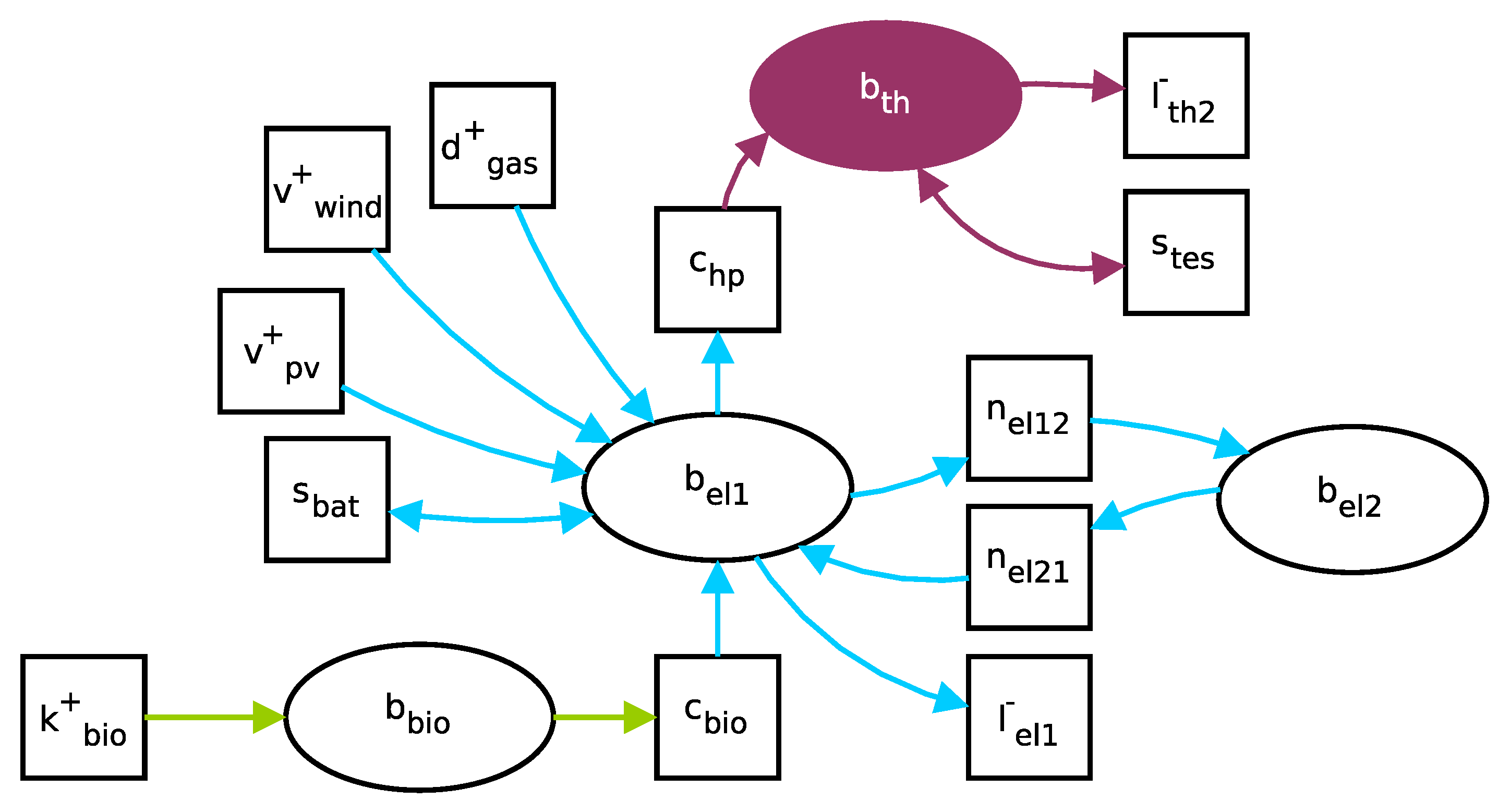
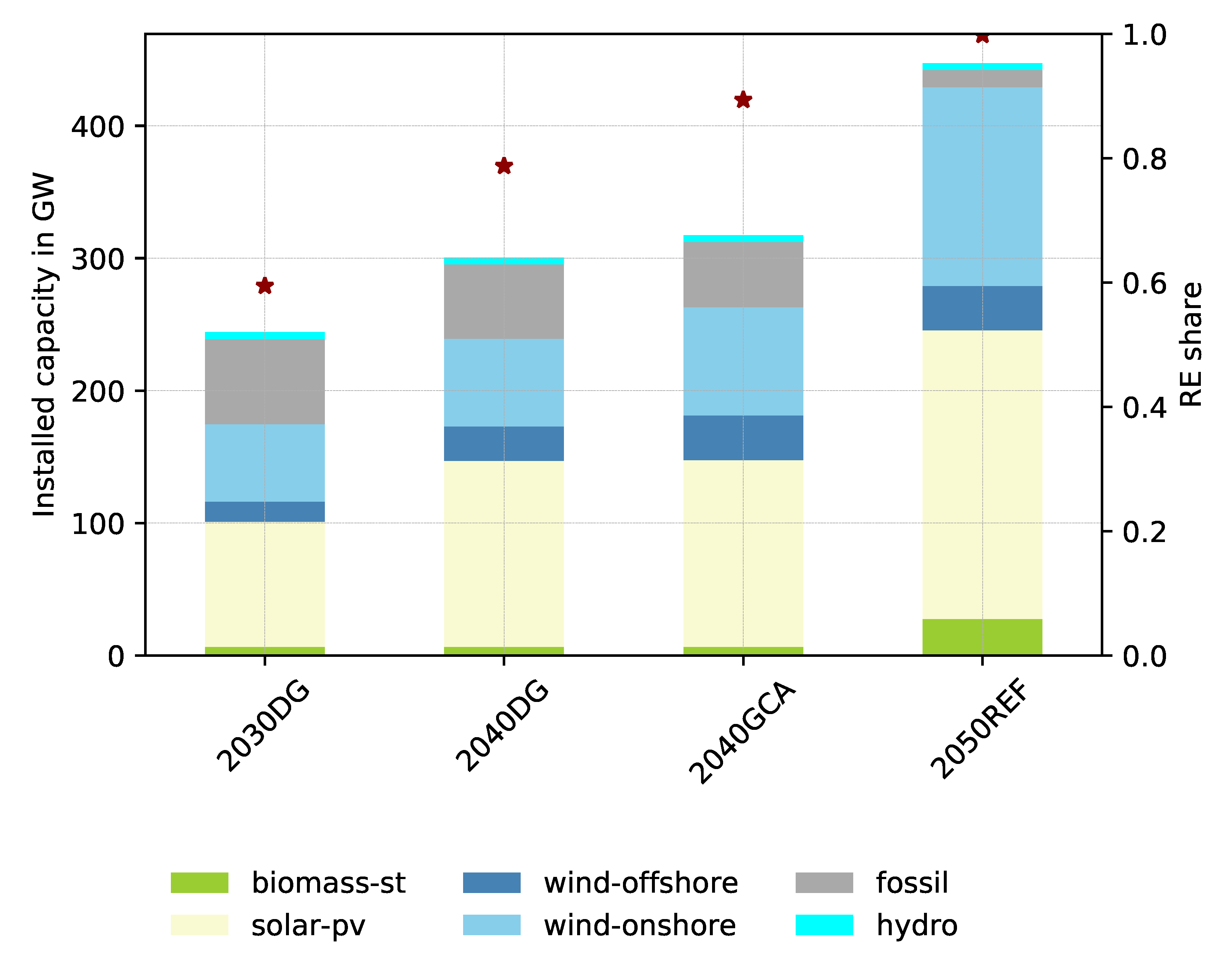

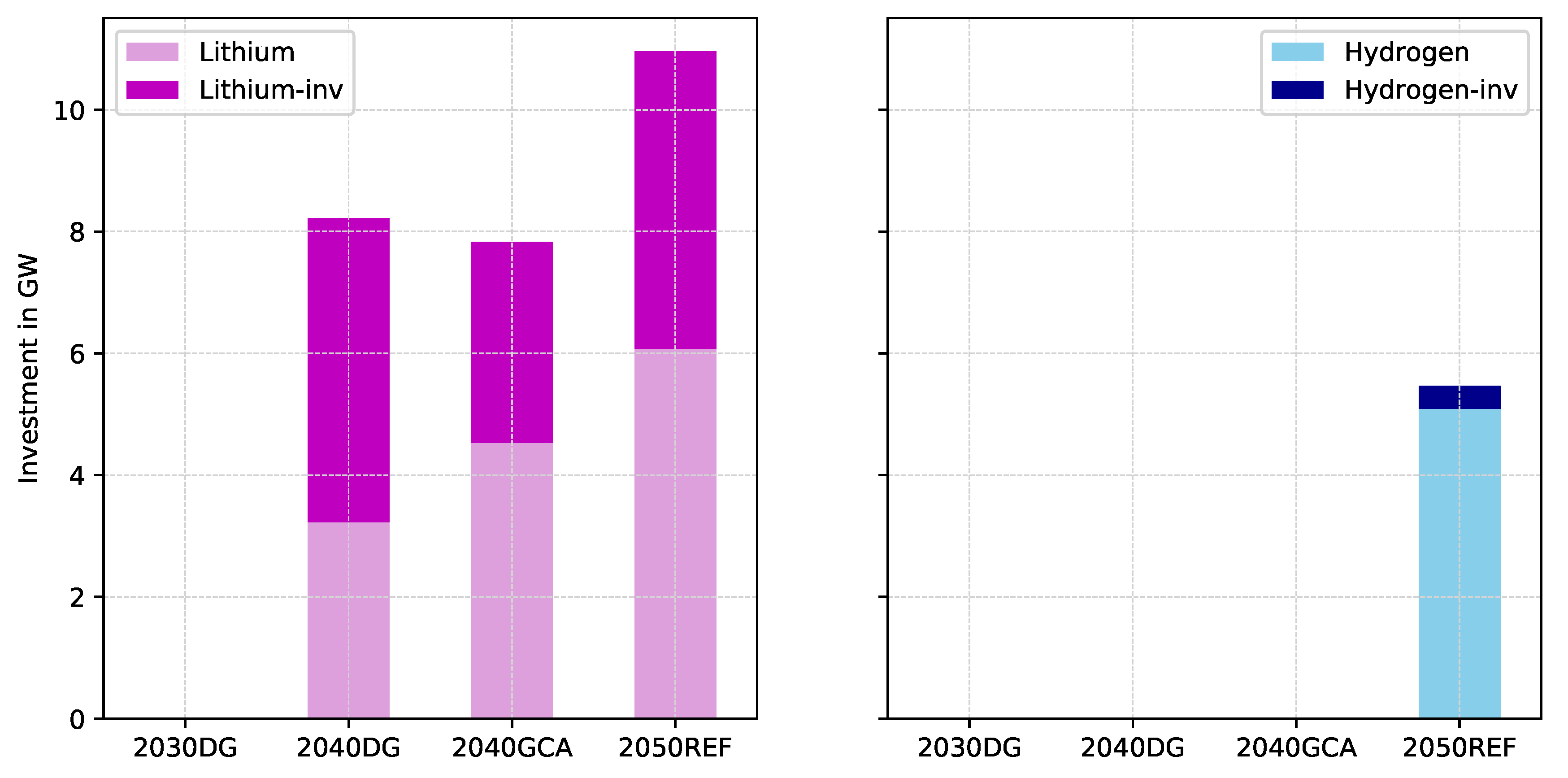
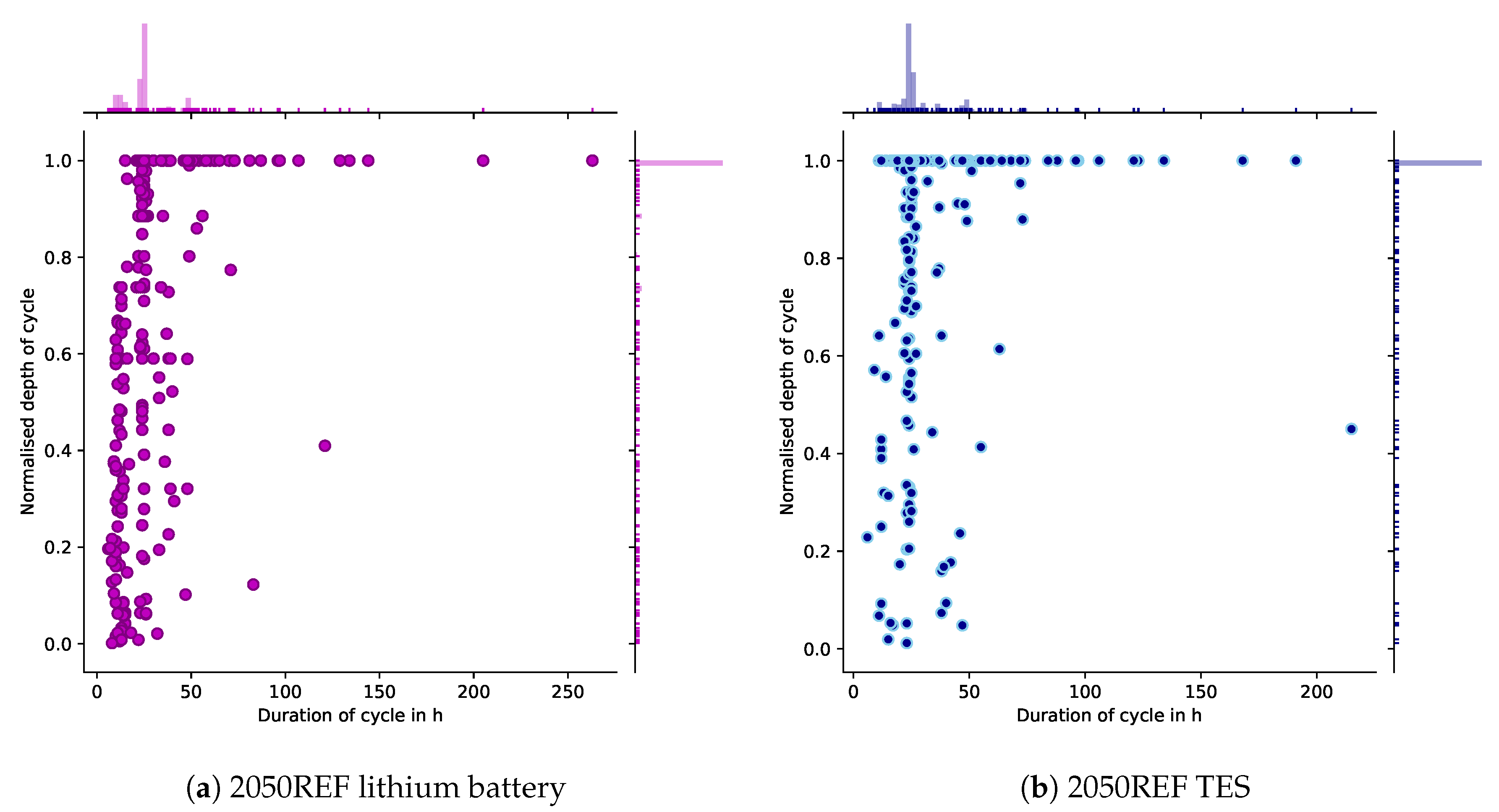
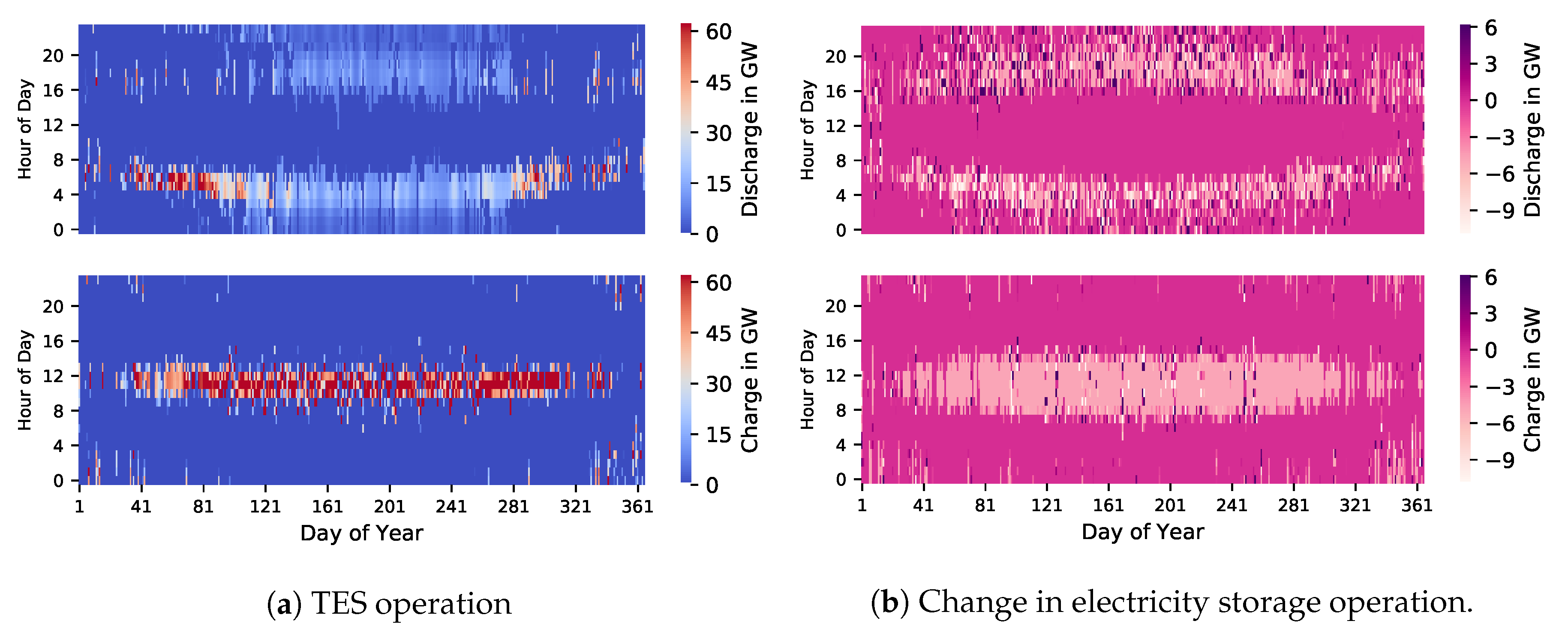
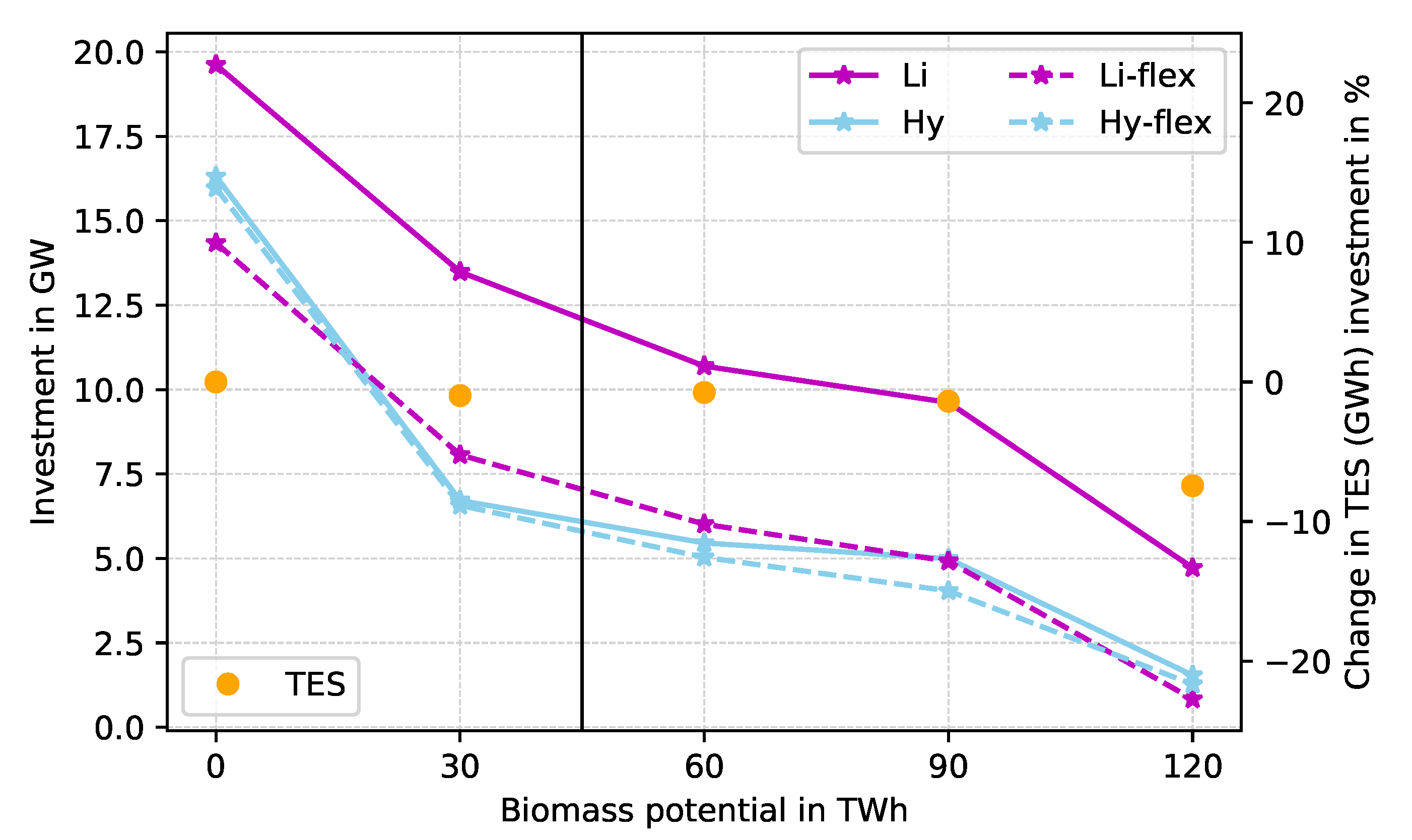
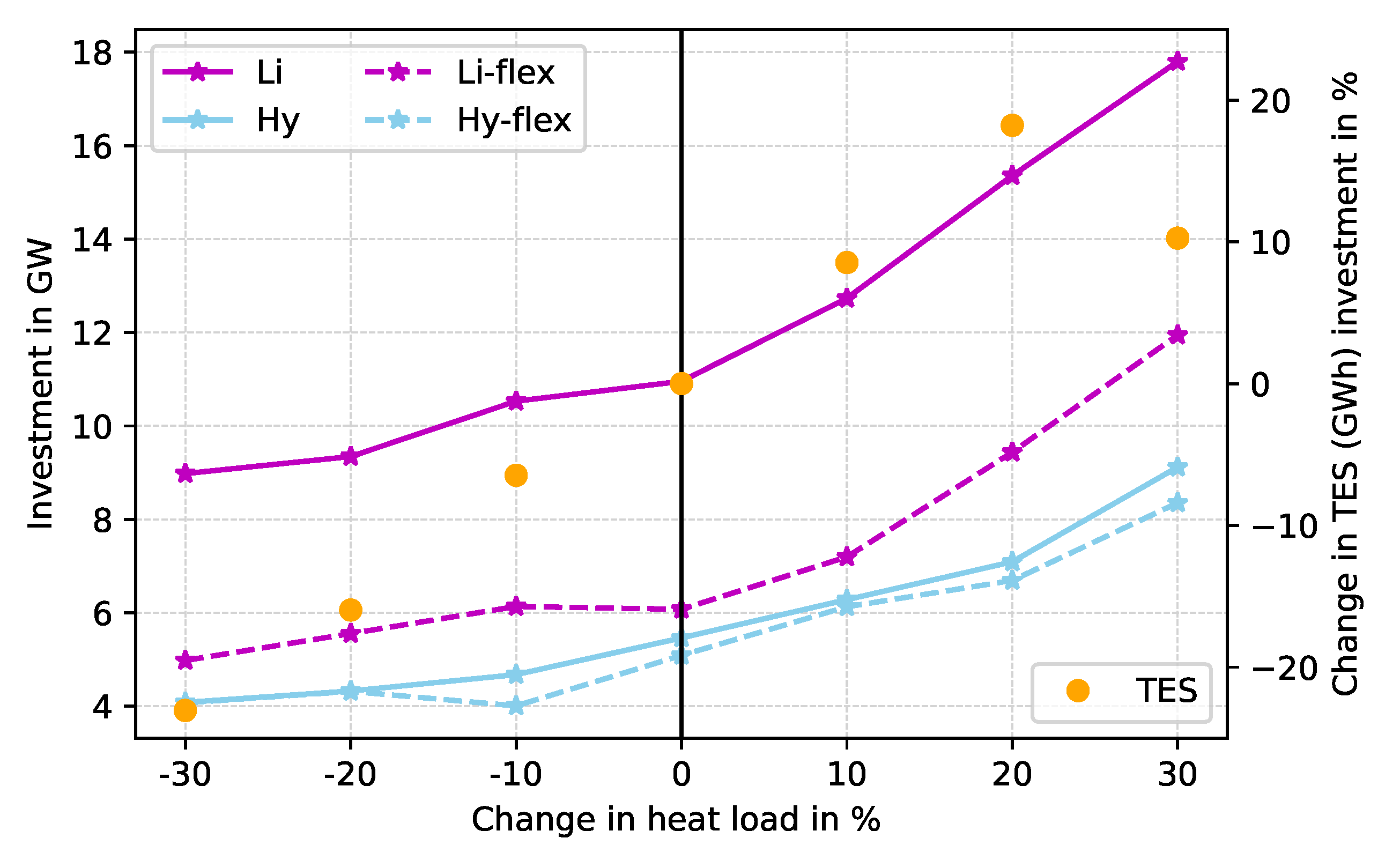
| 2030 | 2040 | 2050 | |
|---|---|---|---|
| Reduction (2008) | 0.10 | 0.125 | 0.15 |
| Electricity demand in TWh | 485 | 471 | 458 |
| Transportation (EVH) in TWh [14] | 30 | 80 | 115 |
| Demand in TWhel | 515 | 551 | 573 |
| Distribution Loss [32], p. 221 | 0.11 | 0.09 | 0.07 |
| Demand incl. losses in TWhel | 571 | 601 | 613 |
| Heat covered by HP in TWhth [14] | 57 | 195 | 284 |
| Investment Cost | FOM | Lifetime | WACC | Efficiency | Storage Capacity | ||
|---|---|---|---|---|---|---|---|
| Euro/kW | Euro/kWh | Euro/kW(h)a | Years | h | |||
| HP | 1400 | - | 49 (Value in Euro/kWa) | 20 | 0.05 | variable | - |
| TES | 0 | 38.4 | 0.39 | 20 | 0.05 | 0.81 | endogenous |
| Lithium 2050 | 35 | 187 | 10 | 20 | 0.05 | 0.92 | 6.5 |
| Hydrogen 2050 | 1000 | 0.2 | 10 | 22.5 | 0.05 | 0.46 | 168 |
| No-Flex (bn Euro) | Flex (bn Euro) | Change (%) | |
|---|---|---|---|
| 2050REF | 22.32 | 22.20 | 0.52 |
| 2040DG | 41.49 | 41.38 | 0.27 |
| 2040GCA | 26.80 | 26.71 | 0.34 |
| 2030DG | 45.38 | 45.38 | 0.00 |
© 2020 by the author. Licensee MDPI, Basel, Switzerland. This article is an open access article distributed under the terms and conditions of the Creative Commons Attribution (CC BY) license (http://creativecommons.org/licenses/by/4.0/).
Share and Cite
Hilpert, S. Effects of Decentral Heat Pump Operation on Electricity Storage Requirements in Germany. Energies 2020, 13, 2878. https://doi.org/10.3390/en13112878
Hilpert S. Effects of Decentral Heat Pump Operation on Electricity Storage Requirements in Germany. Energies. 2020; 13(11):2878. https://doi.org/10.3390/en13112878
Chicago/Turabian StyleHilpert, Simon. 2020. "Effects of Decentral Heat Pump Operation on Electricity Storage Requirements in Germany" Energies 13, no. 11: 2878. https://doi.org/10.3390/en13112878
APA StyleHilpert, S. (2020). Effects of Decentral Heat Pump Operation on Electricity Storage Requirements in Germany. Energies, 13(11), 2878. https://doi.org/10.3390/en13112878




